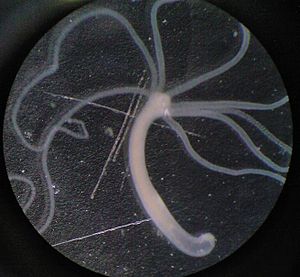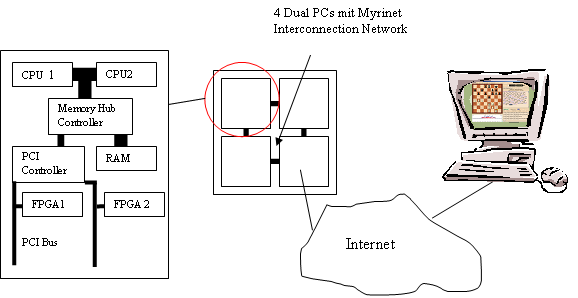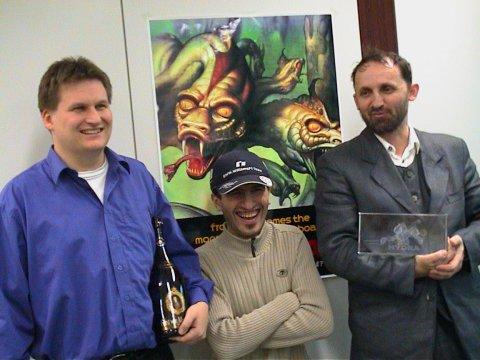Hydra
Hydra,
was a chess playing entity based on a cluster computer containing Field Programmable Gate Arrays, under the patronage of the Pal Group of Companies [3] and Sheikh Tahnoun Bin Zayed Al Nahyan [4] [5] [6] of Abu Dhabi, United Arab Emirates. Chief programmer of Hydra was Chrilly Donninger who already had experience with the former FPGA-Project Brutus. Hydra played its last game in June 2006 [7]. In June 2009, Hydra book author Christopher Lutz stated that "unfortunately the Hydra project is discontinued." The sponsors decided to end the project [8]. Hydra was two times winner of the International Paderborn Computer Chess Championship, the IPCCC 2004 and IPCCC 2005, and was runner up at the ICT 2004.
Contents
System Hydra
System architecture of Hydra [9]
Team Hydra
2006
- Chrilly Donninger - chief programmer
- Abdul Mateen Khan - lead programmer
- Mohammed Nasir Ali - project manager
- Sajeer Mohammed - "Mr. Parallel"
- Arno Nickel - chess consultant
2008
The Hydra team, led by Abdul Mateen Khan, was working on two new chess projects: Cryptic and Shark, as in 2008 mentioned on the now defunct Hydra site, and from May 2008 until December 2009 on Wikipedia [10] [11]:
- Cryptic runs on modern high speed multi-processor CPU. It is programmed in mixed C and Assembly Language. It is aimed to be the world's top single machine Chess Engine.
- Shark is network based deep search meta engine. It is based on unique idea by which it reaches to depth of 25+ easily with the help of only 6 CPUs in less than a minute. Currently a dual core CPU takes more than an hour to reach to this depth.
Former Members
- Ulf Lorenz - parallel computing
- Christopher Lutz - opening book author
- Erdogan Günes - opening book author
Photos
Hydra team 2004: Ulf Lorenz, Erdogan Günes and Chrilly Donninger, IPCCC 2004 [12]
Namesake
Another program by Donninger and Alex Kure was also named Hydra and played the 15th World Microcomputer Chess Championship in Paris 1997.
See also
Publications
- Chrilly Donninger, Ulf Lorenz (2004). The Chess Monster Hydra. in Field Programmable Logic and Application, 14th International Conference, FPL 2004, Leuven, Belgium, August 30-September 1, 2004. Proceedings, pp 927-932. Springer Berlin / Heidelberg, ISBN 978-3-540-22989-6, pdf
- Abstract
- With the help of the FPGA technology, the boarder between hard- and software has vanished. It is now possible to develop complex designs and fine grained parallel applications without the long-lasting chip design cycles. Additionally, it has become easier to write coarse grained parallel applications with the help of message passing libraries like MPI. The chess program Hydra is a high level hardware-software co-design application which profits from both worlds. We describe the design philosophy, general architecture and performance of Hydra. The time critical part of the search tree, near the leaves, is explored with the help of fine grain parallelism of FPGA cards. For nodes near the root, the search algorithm runs distributed on a cluster of conventional processors. A nice detail is that the FPGA cards allow the implementation of sophisticated chess knowledge without decreasing the computational speed.
- Carl Bicknell (2004). Interview with Chrilly Donninger, Subject: Hydra. Selective Search 113, pp. 19, pdf hosted by Mike Watters
- Chrilly Donninger, Ulf Lorenz (2005). The Hydra project. Xcell Journal, Issue 53, pp. 94–97.
- ChessBase, the Editor, John Nunn, David Levy (2005). Adams Outclassed by HYDRA. ICGA Journal, Vol. 28, No. 2
- David Levy (2005). Man vs. Machine – What Next? ICGA Journal, Vol. 28, No. 2
- Peter Vossen (2007). Computer-WM Amsterdam. Computerschach und Spiele Online, pdf1 [13]
- Chrilly Donninger (2007). Flugstunden mit Ken Thompson. pdf (German)
External Links
Chess Entity
- Hydra (chess) from Wikipedia
- Games at chessgames.com
- From Brutus to Hydra - The mathematician Donninger about the evolution of his chess program, Danube University Krems, January 19, 2004
- All about the Hydra chess project, ChessBase News, August 22, 2004
- Adams vs Hydra: Man 0.5 – Machine 5.5, ChessBase News, June 28, 2005
- Checkmate - Documentry on Computer Chess Part 1, 2, YouTube Videos
Misc
References
- ↑ Hydra species filmed with a binocular stereomicroscope his eyes From School hydra jellyfish Hydrozoa Flowers, Category:Hydra (genus) - Wikimedia Commons
- ↑ Lewis Wolpert, Amata Hornbruch, Mike Clarke (1974). Positional Information and Positional Signalling in Hydra. Integrative and Comparative Biology, Vol. 14, No. 2
- ↑ Pal Group of Companies
- ↑ Al Nahyan family from Wikipedia
- ↑ Hydra (chess) from Wikipedia
- ↑ The General Secretariat of the Executive Council - Abu Dhabi - Members' Profiles
- ↑ Who will be the next Freestyle Champion by Arno Nickel, ChessBase News, July 05, 2006
- ↑ Hydra (chess) from Wikipedia
- ↑ Hydra (Schachcomputer) – Wikipedia.de (German)
- ↑ Hydra (chess): 13:34, 30 May 2008 by 80.227.14.13
- ↑ Hydra (chess): 13:57, 16 December 2009 by 217.165.22.102
- ↑ Die Internationalen Paderborner Computerschachmeisterschaften by Mathias Feist, ChessBase Nachrichten, February 17, 2004 (German)
- ↑ Part 1 has an interview with Chrilly Donninger about Hydra


